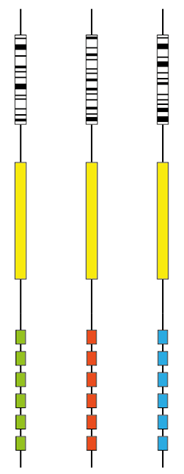
2016年9月8日/生物谷BIOON/–相同的DNA存在于有机体的每个细胞中,但是一些基因仅在一个给定的细胞中表达。作为对多种生物学信号作出的反应,这些基因由被称作转录因子的蛋白所激活。因此,不论在健康时还是在患病时,转录因子调节着大多数细胞过程。
如今,在一项新的研究中,来自瑞士日内瓦大学的研究人员开发出一种新的技术来鉴定参与任何一种细胞过程和对任何一种生物学信号作出的反应的所有转录因子。这种方法的应用几乎是无限的,不论是在医学领域,还是在基础生物学上。相关研究结果发表在2016年8月15日那期Genes & Development期刊上,论文标题为“Unbiased identification of signal-activated transcription factors by barcoded synthetic tandem repeat promoter screening (BC-STAR-PROM)”。
在接受到一种生物学信号后,我们的每个细胞产生某些蛋白,如一个胰腺β细胞合成胰岛素,或者一个白细胞分泌中和微生物的抗体。一旦被这个细胞检测到,这种信号激活一种生物化学级联反应来促进一个给定基因的表达。负责激活这个基因的转录因子结合到位于该基因上游的启动子的特异性DNA序列上。
用于准确靶向的随机DNA
论文通信作者、日内瓦大学理学院分子生物学系名誉教授Ueli Schibler说,“有1000多个人转录因子调节着大多数细胞过程。在很多基础和应用生物学研究项目中,同时鉴定参与多种功能的所有转录因子将节省大量时间。”为此,Schibler和他的团队开发出一种原创性的筛选技术。论文共同第一作者Pauline Gosselin解释道,“我们构建出一种由3000多个启动子组成的文库,其中每个启动子由重复的随机DNA序列、一种发光标记和基因条形码组成。随机序列的重复性极大地增加鉴定一种特异性转录因子的可能性。”
在利用一种生物学信号激活人细胞之前,所有的这些启动子都被导入这些细胞当中。论文共同第一作者Gianpaolo Rando说道,“在这种文库中,由这种信号激活的人工合成基因经转录后产生mRNA。我们随后通过鉴定与它们连接在一起的基因条形码来追踪它们。最终,在一个现存的数据库中,这些启动子中含有的这些重复性的随机DNA序列允许挑选出结合到这些序列上的转录因子。”
一种通用的开创性工具
这种方法被命名为条形码合成串联重复序列启动子(BarCoded Synthetic TAndem Repeat PROMoter, BC-STAR-PROM)筛选,是基于2013年Schibler团队开发的一种技术而开发出来的。Schibler说,“我们对它进行优化以便在单个实验中同时监控大约3000个启动子的活性,而不是将这些启动子逐个地导入到这些细胞中。这意味着节省大量的时间和工作。”
这种BC-STAR-PROM技术能够应用于任何一个旨在探究一种生物学信号或一种化学物的细胞影响的研究项目中。这种具有无限应用的开创性工具能够被用来鉴定一种药物、一种感染或者一种处于开发中的治疗方法激活或抑制的转录因子。利用这种方法,研究人员已经鉴定出被长春花碱(vinblastine)激活的转录因子,其中长春花碱是一种用于治疗不同肿瘤类型的化疗药物。(生物谷 Bioon.com)
本文系生物谷原创编译整理,欢迎转载!点击 获取授权 。更多资讯请下载生物谷APP。
Unbiased identification of signal-activated transcription factors by barcoded synthetic tandem repeat promoter screening (BC-STAR-PROM)
Pauline Gosselin, Gianpaolo Rando1, Fabienne Fleury-Olela and Ueli Schibler
doi:10.1101/gad.284828.116
PMC:
PMID:
The discovery of transcription factors (TFs) controlling pathways in health and disease is of paramount interest. We designed a widely applicable method, dubbed barcorded synthetic tandem repeat promoter screening (BC-STAR-PROM), to identify signal-activated TFs without any a priori knowledge about their properties. The BC-STAR-PROM library consists of ~3000 luciferase expression vectors, each harboring a promoter (composed of six tandem repeats of synthetic random DNA) and an associated barcode of 20 base pairs (bp) within the 3′ untranslated mRNA region. Together, the promoter sequences encompass >400,000 bp of random DNA, a sequence complexity sufficient to capture most TFs. Cells transfected with the library are exposed to a signal, and the mRNAs that it encodes are counted by next-generation sequencing of the barcodes. This allows the simultaneous activity tracking of each of the ~3000 synthetic promoters in a single experiment. Here we establish proof of concept for BC-STAR-PROM by applying it to the identification of TFs induced by drugs affecting actin and tubulin cytoskeleton dynamics. BC-STAR-PROM revealed that serum response factor (SRF) is the only immediate early TF induced by both actin polymerization and microtubule depolymerization. Such changes in cytoskeleton dynamics are known to occur during the cell division cycle, and real-time bioluminescence microscopy indeed revealed cell-autonomous SRF–myocardin-related TF (MRTF) activity bouts in proliferating cells.
 基因君官网
基因君官网